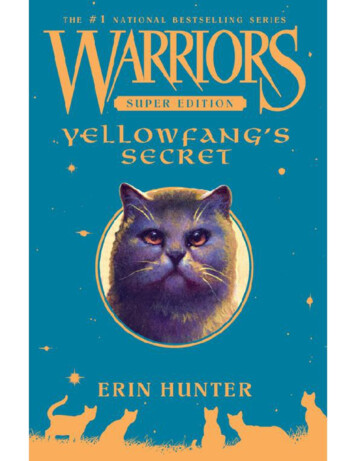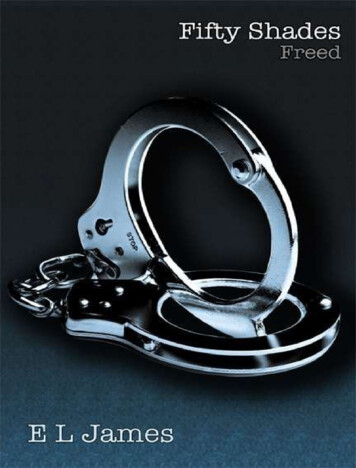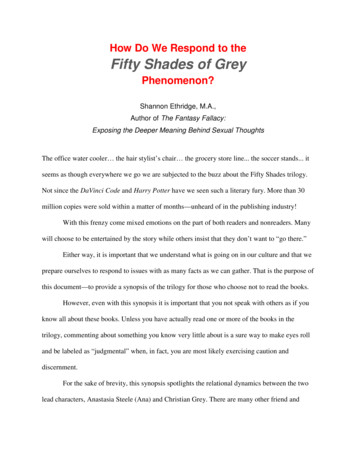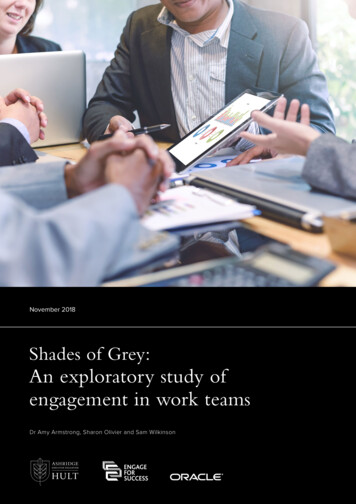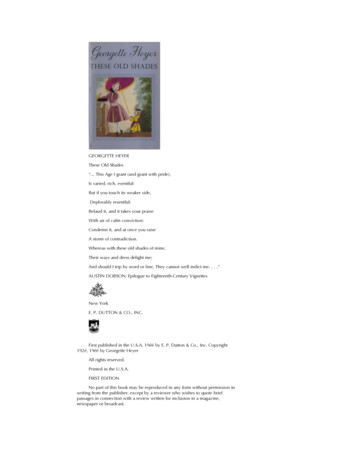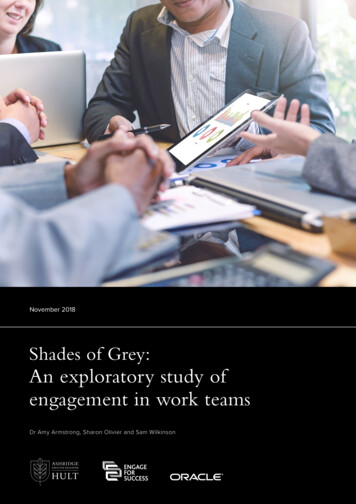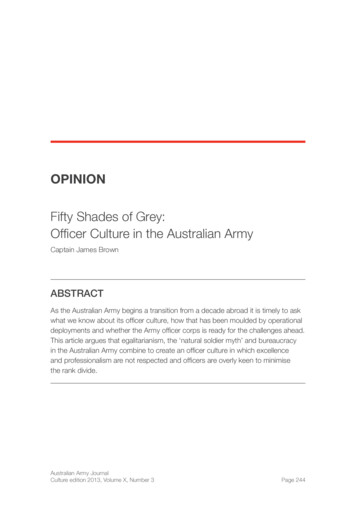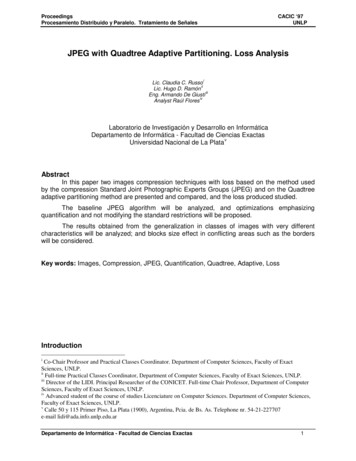
Transcription
Between Shades of Gray Unit PlanOrganized by Rebekah Crawley
Index2
Unit Overview.4Calendar.6Lesson Plans.8Important Worksheets and Handouts.30Ideas and Questions for Discussions.42Final Exam.46Final Project.54Rubric for Oral Presentation/Final Project.57Resources.593
Unit Overview4
1. A paragraph about your theme and why you chose it:-The overall emphasis is on genocide but the themes will focus around courage,compassion, hope, and risk in times of oppression. I have always been a huge fanof historical fiction and nonfiction that focuses on stories of genocides of the 20thCentury. The stories are tragic but I am always so amazed by the hope thecharacters are able to maintain. It is not always easy for them and there aretimes when their courage seems lost but they pull through. I love the manydifferent perspectives I get to read in these stories and I am filled with morecompassion and love when reading these books than any other kind of book.These books can teach students not only academically but also personally. Byreading these novels and focusing on hope and courage they can change who theyare as individuals. They can encourage us to become more compassionate, aware,and loving people.2. The common core standards you will focus on--preferably one fromreading, writing, language, speaking and listening ng: Determine a theme or central idea of a text and analyze itsdevelopment over the course of the text, including its relationship to thecharacters, setting, and plot; provide an objective summary of the text (2).Analyze how particular lines of dialogue or incidents in a story or drama propelthe action, reveal aspects of a character, or provoke a decision (3).- Writing: Draw evidence from literary or informational texts to support analysis,reflection, and research (9). Write routinely over extended time frames (time forresearch, reflection, and revision) and shorter time frames (a single sitting or aday or two) for a range of discipline-specific tasks, purposes, and audiences (10).- Language: Demonstrate command of the conventions of standard Englishgrammar and usage when writing or speaking (1). Use knowledge of languageand its conventions when writing, speaking, reading, or listening (3).- Speaking and Listening: Engage effectively in a range of collaborativediscussions (one-on-one, in groups, and teacher- led) with diverse partners ongrade 8 topics, texts, and issues, building on others’ ideas and expressing theirown clearly (1).4. The text(s) you will focus on:-Between Shades of Gray (BSOG) by Ruta Sepetys- Number the Stars by Lois Lowry (For struggling readers)- Never Fall Down by Patricia McCormick, Night by Elie Wiesel, or Salt to the Seaby Ruta Sepetys (For any readers who want to read more)5. The grade level:-8Th grade (CCSS for each lesson are for grade 8)6. The meeting schedule-length of class period and how often you meet:-70 minutes each school day5
Calendar6
Lesson Topic1Introduction2Genocide3Reading Group 14Making aConnection5Reading Group 26Risk7Reading Group 38Gulag9Reading Group 410Bystanders toGenocide11Reading Group 512Courage andHope13Reading Group 614Test Day15ProjectPresentationActivitiesAnticipation guide(part 1). BSOGintro videos andinfo.Begin GenocideJournal. Genocidediscussion.“Reporter onAssignment.”Cattle Car Activity.Literature Circle.Journal. PoetryAnalysis. ArtProject.Journal. LiteratureCircle.Journal. Analysis ofRisk and famousquotes.Confession PapersActivity. LiteratureCircle.Journal. GulagGroup researchproject andpresentation.Journal.History Channelvideo. RAFTJournal. Articles.Journal. ipation Guide(part 2). LiteratureCircle.Test. Work on FinalProject.Presentations.7AssessmentAnticipation Guide anddiscussionJournal, discussion, and articleLiterature Circle Role sheet anddiscussionJournal, discussion, poetryannotation, form of expressionJournal, Literature Circle Rolesheet, and discussionJournal and discussionConfession Papers Response,Literature Circle Role sheet, anddiscussionGulag presentation anddiscussionLiterature Circle Role sheet anddiscussionJournal. Discussion.Journal, Literature Circle Rolesheet, and discussionJournal, Documentary write-up,discussion, and responseLiterature Circle Role sheet,anticipation guide, anddiscussionTestProject and oral presentation
Lesson Plans8
Lesson 1: IntroductionSWBAT: Prepare to learn about difficult topics and use their prior knowledge tohelp them make decisions.Opening Activity: As a pre-reading activity, students will complete ananticipation guide structured in the following manner:BeforeReadingAfterReadingStatementsWhen in danger, it is best to play it safe rather than take arisk.In a survival situation, one must make decisions that arebest for themselves and their family members, even ifharm may come to others as a result.Losing some individual freedom is acceptable if it benefitsthe community or society as a whole.If you disagree with a rule, law, or public policy, it is betterto remain silent than to speak out and risk punishment.Commitment to duty and honor should outweigh individualmisgivings in times of moral crisis.A civilized society would ensure that its functions neverallow a child to be harmed intentionally.Instruct students to complete the guide by placing a plus sign in the box next tothe statements with which they agree and a zero next to those with which theydisagree. They must commit to agreement or disagreement—there are noconditional responses. Students should be assured that there are no correct orincorrect positions.Once students have had the opportunity to complete the guide, read eachstatement aloud and have students who agree show it by standing or raising theirhands. Each student should be permitted to provide their rationale for agreeing ifthey wish. (The process is repeated after reading the text(s), with students beinggiven the opportunity to provide their rationales for keeping or changing theirpositions.)Introduction to unit topic: For the next few weeks the class will be focusing on thetopic of genocide. It is a particularly distressing topic that is often discussed withstudents in regard to the Holocaust. Discuss the importance of why we focus onthis topic. Help them to understand that by learning about this topic we becomemore enlightened and when we acknowledge the difficult reality of this dreadfulact we can become more compassionate. When we become a more aware andcompassionate people the likelihood of this event occurring again is lessened. Oneof our goals is to understand why this occurs and how we can stop it.9
Introduction to Between Shades of Gray: Provide each student with his or hercopy of the book (the 2011 hardcover was used as a reference for this guide).Invite a student to read the synopsis on the inside cover of the novel. Ask whohas heard of Joseph Stalin and the genocide he inflicted upon those under Sovietrule. To deepen their understanding and prepare them for reading they will viewthe twelve-minute video found here: http://www.betweenshadesofgray.com. Asthey watch the video they will take notes in their journal regarding anyquestions, concerns, or thoughts that came to their mind as they watched thevideo.Unit Description: Take this time to go over what the students will be doing for thenext three weeks (Teacher’s Note: This Unit Plan can easily be expanded to fit alarger time-span, and will likely take more time anyway to accommodate theneeds of students). Provide them with and take them through the BETWEENSHADES OF GRAY UNIT PACKET (this is found below in “Important Worksheetsand Handouts”), which includes Literature Circle sheets and a reading schedule:Day 1-2: Chapters 1-16 (Pages 3-61—58 pages)Day 3-4: Chapters 17-31 (Pages 62-119—57 pages)Day 5-6: Chapters 32-46 (Pages 120-185—65 pages)Day 7-8: Chapters 47-60 (Pages 186-241—55 pages)Day 9-10: Chapters 61-75 (Pages 242-300—58 pages)Day 11-12: Chapters 76-end (Pages 301-338—37 pages)Inform them of the final test and the final project (they will get the directions at alater date). Also introduce them to the Literature Circle Role Sheets, give themthe packets, and divide the class into groups of six. Days listed as “ReadingGroup” will typically go the same way. Students have been divided into groups ofand given a packet where each sheet gives each student a different role for thatday of group discussion. The worksheets are under “Important Worksheets andHandouts”. The packets should be stapled so that as long as each person goes inorder, no one will have the same role on any Reading Group day.Closing: Have a discussion about what they would like to learn about the topic ofgenocide. What have they already heard? What are they tired of hearing? Arethere any aspects of it that they are uncertain about? Consider their responsesfor any unit plan modifications. Watch this short book trailer to peek interest:https://www.youtube.com/watch?v u630dERY5ScHomework: Day 1-2: Chapters 1-16 (Pages 3-61—58 pages)10
Lesson 2: GenocidesCCSS: Draw evidence from literary or informational texts to support analysis,reflection, and research (Writing 8.9).Write routinely over extended time frames (time for research, reflection, andrevision) and shorter time frames (a single sitting or a day or two) for a range ofdiscipline-specific tasks, purposes, and audiences (Writing 8.10).SWBAT: Draw evidence from text to support reflection and research.Journal: Students will make a list of the genocides they are aware of with shortexplanations of where, why, and when they occurred.Instruction: Have a class discussion to define the word genocide. What do theythink it is? What do they think causes it? Who do they think starts it? Get themthinking about all the aspects of it. (Definition: Genocide is the deliberate andsystematic destruction, in whole or in part, of an ethnic, racial, religious, ornational group.)Going back to their journal, discuss the genocides they wrote down. What didthey put? What did they miss? Using the timeline located under “ImportantWorksheets and Handouts” identify all the genocides that have occurredthroughout the 20th century. Are they surprised? Why?Identify that genocide occurs a lot more than we expect: “When the GenocideConvention was passed by the United Nations in 1948, the world said, “Neveragain.” But the history of the twentieth century instead proved that “neveragain” became “again and again.” The promise the United Nations made wasbroken as, again and again, genocides and other forms of mass murder killed170 million people, more than all the international wars of the twentiethcentury combined.” Clarify the important understandings that should resultfrom the day’s work:1. Systems can create inequalities.2. Genocides are avoidable. Each event was the result of government decisions,compliance of citizens, and the lack of interference from other nations.3. Genocides bring out the very best (e.g., sacrifice to help the suffering ofhumanity) and the very worst of humanity, (e.g., no reaction to the suffering ofhumanity).Class Discussion: Have a class discussion using some of the genocide questionsunder the “Ideas and Questions for Discussion” section not yet used.The Eight Stages of Genocide: The term genocide did not exist before 1944. Whileserving in the U.S. State Department, Gregory Stanton studied the genocide inCambodia. Subsequently, in analyzing the genocide in Rwanda, he sawsimilarities between both and realized that the Rwandan genocide developed in11
the same way as the genocide in Cambodia. The result of his findings was hisEight Stages of Genocide, which he presented to the US State Department in1996. He established that these stages are the steps that each genocide goesthrough. In examining the Darfurian genocide, one may surmise that it followsthe same course. Using the “Eight Stages of Genocide” worksheet found under“Important Worksheets and Handouts”, walk through the steps and welcome anyexamples the students may be aware of. Identify that while they read BetweenShades of Gray they should be able to identify these steps.Activity: Students will be a “Reporter on Assignment.” They will have the rest ofthe class period to write a short article describing a particular genocide. Beginthe article with a strong title that will captivate the audience. Include anyappropriate background to better understand the event. Give details to explainthe event and answer who, what, when, where, why.Closing: Ask students to start thinking about what they would do if they heard agenocide was occurring in another country today.Homework: Students must finish the book up to chapter 16 and finish firstreading group worksheet.12
Lesson 3: Reading Group 1CCSS: Engage effectively in a range of collaborative discussions (one-on-one, ingroups, and teacher- led) with diverse partners on grade 8 topics, texts, andissues, building on others’ ideas and expressing their own clearly (Speaking &Listening 8.1).Determine a theme or central idea of a text and analyze its development over thecourse of the text, including its relationship to the characters, setting, and plot;provide an objective summary of the text (Reading: Literature 8.2).SWBAT: Communicate more proficiently and demonstrate their ability to workwith a group.Opening Activity: Pushing the desks aside to make a large space in the middle,the instructor will use tape to identify the standing/sitting room of the cattle carsLina and the others are forced to ride in. The rectangle should be about 26’2” by8’10” (may require further investigation). This activity works best with a largeclass. As students come into class, instruct them to come into the taped area.Encourage those who come in first to sit. Once everyone is in the “cattle car”turn off the lights (it would be cool to also find sound effects for the time theyspend in the car). Instruct the students that this is a serious moment. Ask themto contemplate what they are feeling as they sit/stand in the car. Invite them tocontemplate how they would feel if they were in Lina’s situation. After about 5 orso minutes (don’t let them get restless), allow the students to spread out on thefloor. Sit with them and discuss the experience. (Remind them that on page 35Lina says that she “counted the people—forty-six packed in a cage on wheels,maybe a rolling coffin.”)Reading Group: Release the class to reorganize the desks into their readinggroups. For the next half hour they will discuss the first few chapters of the bookusing their Literature Circle Role sheets. The instructor will go around to thegroups offering help, adding to the discussion, or simply listening.Class discussion: Move the desks into one large circle. Take the time to discusswhat they have concluded in their groups. Do they still have questions? What dothey want to discuss? Allow them to lead the discussion on their own as much aspossible. (If discussion questions are needed to promote interaction, manychoices can be found under “Ideas and Questions for Discussion”)Homework: Day 3-4: Chapters 17-31 (Pages 62-119—57 pages)13
Lesson 4: Making a ConnectionCCSS: Cite the textual evidence that most strongly supports an analysis of whatthe text says explicitly as well as inferences drawn from the text. (Reading:Literature 8.1)By the end of the year, read and comprehend literature, including stories,dramas, and poems, at the high end of grades 6-8 text complexity bandindependently and proficiently. (Reading: Literature 8.10)SWBAT: Analyze and interpret poetry. Create their own poetry and another formof art to express a personal message.Opening Activity: In their journals, have students write a short poem as if theywere experiencing genocide in their own country. They can take on theperspective of someone being taken from their home, someone taking peoplefrom their homes, or someone watching people take their neighbors from theirhomes. It can take any form but must be descriptive and portray certainemotions. Don’t just tell—show. Invite those who want to, to perform their poemin front of the class.Discussion: From what they have learned and read about so far, what are theyfeeling? Give them the opportunity to express any concerns or questions theymay have.Poetry: Move on from the discussion by giving students two poems: First TheyCame For The Jews by Martin Niemöller and Something by Michael R. Burch(found under “Important Worksheets and Handouts”). Identify the authors andimportant information (Martin Niemöller (1892–1984) was a prominentProtestant pastor who emerged as an outspoken public foe of Adolf Hitler andspent the last seven years of Nazi rule in concentration camps. Michael R. Burchis an American poet and a leading online editor and publisher of Holocaust,Hiroshima, Trail of Tears, Darfur, Haiti and Nakba (the Arabic term for theevents of 1948, when many Palestinians were displaced from their homeland bythe creation of the new state of Israel) poetry.). Read the two poems out loud andthen dismiss the students to work individually to analyze and annotate thepoems. After ten or so minutes, allow them to work with a partner.Class Discussion: Discuss what they discovered about the poems. What did theylearn? What did they feel? Could they picture themselves in Niemöller’s poem?Did the poems upset them? Allow the students to lead the discussion.Instruction: Identify the power poetry has to tell a story. Connect it to Lina’sartwork and her ability to use it to portray her emotions. Identify other forms ofexpressing one’s self.14
Activity: Give students the rest of the class period to portray an importantmessage they have (it can be about anything appropriate) in some form of art.They can work individually or with a group. It can be poetry, art, dance, music,etc. If there is time, several students can present their work to the class.Homework: Students must finish the book up to chapter 31 and finish secondreading group worksheet.15
Lesson 5: Reading Group 2CCSS: Engage effectively in a range of collaborative discussions (one-on-one, ingroups, and teacher- led) with diverse partners on grade 8 topics, texts, andissues, building on others’ ideas and expressing their own clearly (Speaking &Listening 8.1).Determine a theme or central idea of a text and analyze its development over thecourse of the text, including its relationship to the characters, setting, and plot;provide an objective summary of the text (Reading: Literature 8.2).SWBAT: Present what they have learned so far from the book and explain itsimportance to their classmates.Journal: Students will answer the question “If you were any character in thereading is there something you would do differently? What would it be and why?”Final Project Instruction: Students will be given the directions to the final projectfor the unit (Directions are listed under “Final Project”. The different options willbe explained to them and they will be notified that on the final day of the unitthey must give an oral presentation of their project.Reading Group: Release the class to reorganize the desks into their readinggroups. For the next half hour they will discuss the first few chapters of the bookusing their Reading Group worksheets. The instructor will go around to thegroups offering help, adding to the discussion, or simply listening.Class discussion: Move the desks into a one large circle. Take the time to discusswhat they have concluded in their groups. Do they still have questions? What dothey want to discuss? Allow them to lead the discussion on their own as much aspossible. (If discussion questions are needed to promote interaction, manychoices can be found under “Ideas and Questions for Discussion”)Closing: Ask the students to think about risk. What is it? What is worth taking arisk?Homework: Day 5-6: Chapters 32-46 (Pages 120-185—65 pages)16
Lesson 6: RiskCCSS: Analyze how particular lines of dialogue or incidents in a story or dramapropel the action, reveal aspects of a character, or provoke a decision (Reading:Literature 8.3).SWBAT: Demonstrate their ability to think critically and present their ideasskillfully.Journal: Students will answer the question “What are three things you would risktaking with you if you were being forced from your home? Is it a risk worthtaking? Why?”Class discussion: What is risk? What is worth taking a risk? What kind of persontakes risks? What are possible outcomes of risk--both positive and negative?Using what they wrote in their journals earlier, what are some things that theywould risk taking with them and why? Is it worth the risk?Journal Continued: Put the following quotations on the board and ask studentswhat they’re feeling and their opinion about risk. Do they agree with the quotes?Do they disagree? Why? They will write their response in their journals forabout ten minutes.a. “All glory comes from daring to begin.” (anonymous)b. “To achieve great things, we must live as though we were never going todie.” (Vauvenargues)c. “If one is forever cautious, can one remain a human being?” (AlexandrSolzhenitsyn)d. “Survival is triumph enough.” (Harry Crews)e. “Great men are not always wise.” (Job 32:9)f. “The only thing we have to fear is fear itself.” (Franklin D. Roosevelt)Group discussion: In groups of three or four the students will look through thechapters they have read so far and identify times when any character has takena risk. They must define whether it was worth it or not (explain why) andidentify any consequences. They will chart what they find on a piece of paper thatwill later be turned in.Class Discussion: The class will come back together as a giant circle and discusswhat they have found. What are their final thoughts? Do they disagree with anycharacters? Why or why not? What would they do in their situation? Does yourwillingness to take a risk change depending on if you are responsible for others—how is this idea shown in the book?Closing: Challenge them to continue to identify where risks are taken in the bookand to consider what they would do in the situation. Also, challenge them to17
recognize where they, or those close to them, take risks and to consider if therisk is worth the consequence.Homework: Students must finish the book up to chapter 46 and finish thirdreading group worksheet.18
Lesson 7: Reading Group 3CCSS: Engage effectively in a range of collaborative discussions (one-on-one, ingroups, and teacher- led) with diverse partners on grade 8 topics, texts, andissues, building on others’ ideas and expressing their own clearly (Speaking &Listening 8.1).Determine a theme or central idea of a text and analyze its development over thecourse of the text, including its relationship to the characters, setting, and plot;provide an objective summary of the text (Reading: Literature 8.2).SWBAT: Present what they have learned so far from the book and explain itsimportance to their classmates.Opening Activity: In Between Shades of Gray, readers learn of the diabolicalsystem devised by Stalin’s government to deal with dissenters or anyone itperceived as a threat to the regime. In part, the system was designed to useconfusion, brutality, and alienation to force confessions to whatever crimes thestate might trump up against them. The text indicates that things went easier onthose who confessed, but Elena and many of the others continued to refuse.Students will get into groups of four and will decide together the pros and cons ofsigning the NKVD’s confession papers. As a group, they must come to aunanimous agreement on whether or not their group signs the papers. As theydiscuss, they will consider the experiences of Lina and her family and friends aswell as those who signed, and use textual evidence to provide specific examplesto support their case. Remind them to consider what we have discussed aboutrisk. The class will then discuss the stance they have taken and each side willexplain their reasoning to the other.Reading Group: Release the class to reorganize the desks into their readinggroups. For the next half hour they will discuss the first few chapters of the bookusing their Reading Group worksheets. The instructor will go around to thegroups offering help, adding to the discussion, or simply listening.Class discussion: Move the desks into a one large circle. Take the time to discusswhat they have concluded in their groups. Do they still have questions? What dothey want to discuss? Allow them to lead the discussion on their own as much aspossible. (If discussion questions are needed to promote interaction, manychoices can be found under “Ideas and Questions for Discussion”)Homework: Day 7-8: Chapters 47-60 (Pages 186-241—55 pages)19
Lesson 8: GulagCCSS: Come to discussions prepared, having read or researched material understudy; explicitly draw on that preparation by referring to evidence on the topic,text, or issue to probe and reflect on ideas under discussion. (Speaking &Literature 8.1A)SWBAT: Develop their research skills as they search for information on a newtopic.Journal: Students will respond to the question, “The majority of the book is set inthe Soviet Gulag (prison camp) system, although Sepetys does not use thatspecific term. How does the book explain why the Soviet Union did what it did in1941, and how does it explain the actions of the NKVD?” (This step may requiresome setting up. Identify that the labor camps Lina and the others have been inare a part of the Soviet Gulag system.)Activity: The Soviet gulag system is one of the most notorious prison systems inhistory, and considerable historical evidence indicates that it claimed tens ofmillions of lives. Divide students into groups to investigate the elements of thegulag system:a. Siberia & the Geography of the Gulag: investigate Siberia’s historical roleas a region of exclusion for Russia. Examine maps of the gulag network,and develop a rationale for the placement, movement, and purpose of thecamps (which had a labor as well as an incarceration function). Comparethe locations of the camps to a population density map of the SovietUnion over time. !b. The Gulag in Literature: examine excerpts from texts such as One Day inthe Life of Ivan Denisovich, The Gulag Archipelago, Kolyma Tales,Everything I Possess I Carry With Me, and In The First Circle. Comparethe representations of the gulag and prison life in these works. !c. Gulag Prisoners: whether sent to prison by the tsars or the communistdictators, prisoners in the gulag like Lina and her family were often nottypical violators of the law. Investigate the groups targeted for imprisonment in Siberia over the course of Russian history, who were often jailedfor religious, ethnic, intellectual, or political affiliations. !Presentation: Groups will present their information to the class and answer anyquestions. 3-5 minutes each.Class Discussion: Once all groups have presented the class will have a groupdiscussion in a large circle. What were they surprised to learn? How did learningabout this make them feel? Knowing about Lina and her experience, how wouldthey handle being in her or her fellow prisoners’ shoes? Connecting the gulagsystem back to the eight stages of genocide, what purpose do gulags serve in20
genocide? What do they do to the people? These gulags were set up in manydifferent areas, why did no one living near them try to put a stop to it?Homework: Students must finish the book up to chapter 60 and finish fourthreading group worksheet.21
Lesson 9: Reading Group 4CCSS: Engage effectively in a range of collaborative discussions (one-on-one, ingroups, and teacher- led) with diverse partners on grade 8 topics, texts, andissues, building on others’ ideas and expressing their own clearly (Speaking &Listening 8.1).Determine a theme or central idea of a text and analyze its development over thecourse of the text, including its relationship to the characters, setting, and plot;provide an objective summary of the text (Reading: Literature 8.2).SWBAT: Present what they have learned so far from the book and explain itsimportance to their classmates.Journal: Students will respond to the question, “How does the author use theembedded flashbacks to help readers understand why Lina’s family has beenrounded up for punishment? Do you agree with the family’s choices? Why or whynot?”Reading Group: Release the class to reorganize the desks into their readinggroups. For the next half hour they will discuss the first few chapters of the bookusing their Reading Group worksheets. The instructor will go around to thegroups offering help, adding to the discussion, or simply listening.Class discussion: Move the desks into a one large circle. Take the time to discusswhat they have concluded in their groups. Do they still have questions? What dothey want to discuss? Allow them to lead the discussion on their own as much aspossible. (If discussion questions are needed to promote interaction, manychoices can be found under “Ideas and Questions for Discussion”)Closing: Consider the people who lived near
Introduction to Between Shades of Gray: Provide each student with his or her copy of the book (the 2011 hardcover was used as a reference for this guide). Invite a student to read the synopsis on the inside cover of the novel. Ask who has heard of Joseph Stalin an

